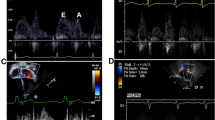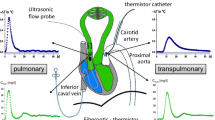Summary
The ratio of pulmonary vascular resistance to systemic resistance was determined before and after oxygen administration in 25 children with an isolated large ventricular septal defect and elevated pulmonary vascular resistance (pulmonary/systemic resistance ratio, Rp/Rs>0.25). A fall of 30% or more in the Rp/Rs, after 20 minutes of oxygen inhalation (F1O2>0.90), was considered a positive response to oxygen. In the 6 children with Down's syndrome, the Rp/Rs fell significantly more in oxygen (52%) than it did in the 19 children without Down's syndrome (31%, p<0.05). No other clinical or baseline hemodynamic finding was predictive of vascular responsiveness.
Seventeen children underwent closure of the ventricular septal defect. Three of 11 children who responded to O2 expired shortly after operation; each of the 6 children who did not respond to O2 survived operation. Two of the deaths (occurring less than 12 hours after closure) were from low cardiac output; a third child died suddenly 5 days postoperatively. Thirteen children, 7 who responded to oxygen and 6 who did not, were restudied by cardiac catheterization an average of 2.0 years following successful closure of the ventricular septal defect. While the Rp/Rs in room air fell following closure of the defect in both groups, the decrease was 22% in responders and 28% in nonresponders.
The results of this study, unlike similar studies performed at higher altitudes, suggest that the preoperative responsiveness of the pulmonary vasculature to oxygen does not predict either operative survival or postoperative pulmonary vascular resistance.
Similar content being viewed by others
References
Auld PAM, Gibbons JE, McGregor M: Vasomotor tone in the pulmonary vascular bed in patients with left-to-right shunts.Br Heart J 25:257–261, 1963
Blount SG Jr, Woodwark GM: Considerations involved in the selection for surgery of patients with ventricular septal defects.Am J Cardiol 5:223–233, 1960
Burchell HB, Swan HJC, Wood EH: Demonstration of differential effects on pulmonary and systemic arterial pressure by variation in oxygen content of inspired air in patients with patent ductus arteriosus and pulmonary hypertension.Circulation 8:681–694, 1953
Chi TL, Krovetz LJ: The pulmonary vascular bed in children with Down's syndrome.J Pediatr 86:533–538, 1975
Friedli B, Kidd BSL, Mustard WT, Keith JD: Ventricular septal defect with increased pulmonary vascular resistance.Am J Cardiol 33:403–409, 1974
Kimball KG, McIlroy MB: Pulmonary hypertension in patients with congenital heart disease.Am J Med 41:883–897, 1966
Krongrad E, Helmholz HF Jr, Ritter DG: Effect of breathing oxygen in patients with severe pulmonary vascular obstructive disease.Circulation 47:94–100
Marshall HW, Swan HJC, Burchell HB, and Wood EH: Effect of breathing oxygen on pulmonary artery pressure and pulmonary vascular resistance in patients with ventricular septal defect.Circulation 23:241–252, 1961
Park CD, Nicodemus H, Downes JJ, Miller WE, and Waldhausen JA: Changes in pulmonary vascular resistance following closure of ventricular septal defects.Circulation Supp 1:1-193–1-200, 1969
Plett JA, Tandon R, Moller JH, Edwards JE: Hypertensive pulmonary vascular disease.Arch Pathol 97:187–188, 1974
Sigmann JM, Perry BL, Behrendt DM, Stern AM, Kirsh MM, Sloan HE: Ventricular septal defect: Results after repair in infancy.Am J Cardiol 39:66–71, 1977
Snedecor GW, Cochran WG:Statistical Methods, 6th ed. Iowa State University Press, Ames, 1967 p 115
Teramoto S, Fujiwara T, Takahara I: Study of hemodynamic changes with oxygen inhalation in VSD associated with pulmonary hypertension.Jap Cir J 40:623–627, 1976
Vogel JHK, Grover RF, Jamieson GG, Blount SG Jr: Long-term physiologic observations in patients with ventricular septal defect and increased pulmonary vascular resistance.Adv Cardiology 11:108–122, 1974
Vogel JHK, McNamara DG, Blount SG Jr: Role of hypoxia in determining pulmonary vascular resistance in infants with ventricular septa defects.Am J Cardiol 20:346–349, 1967
Author information
Authors and Affiliations
Additional information
This work was supported by the Dwan Family Fund, and was part of the Ray C. Anderson Symposium.
Rights and permissions
About this article
Cite this article
Lock, J.E., Einzig, S., Bass, J.L. et al. The pulmonary vascular response to oxygen and its influence on operative results in children with ventricular septal defect. Pediatr Cardiol 3, 41–46 (1982). https://doi.org/10.1007/BF02082331
Issue Date:
DOI: https://doi.org/10.1007/BF02082331




